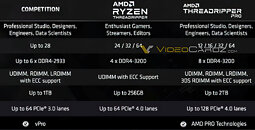Friday, July 10th 2020

Rumor: AMD Ryzen Threadripper PRO Lineup Leaked
Videocardz seems to have snagged some official AMD slides detailing their upcoming Threadripper PRO lineup. AMD is tiering its Threadripper CPU offerings between the Threadripper and Threadripper PRO via added functionality that AMD considers is better suited to the prospective buyers of a PRO-branded Threadripper: professional studios, designers, engineers and data scientists. AMD's positioning for these creatives or scientists is to offer a much improved platform throughput compared to Threadripper: the PRO version supports up to 128 PCIe 4.0 lanes (64 in non-PRO); up to 2 TB of ECC memory support (either in UDIMM (Unbuffered DIMM), RDIMM (Registered DIMM), LRDIMM (Load-Reduced DIMM) and 3DS (three-dimensional stacking) RDIMM vi an 8-channel configuration (4-channel in non-PRO); as well as professional-oriented tools and features such as Pro Security, Pro manageability, and PRO business ready support.
Four different CPUs will reportedly be offered in the Threadripper PRO lineup: the 64-core 3995WX is a relatively known quantity by now; likewise, the 3975WX will mirror consumer parts core counts (32 cores), both with reduced clocks by 100-200 MHz compared to their non-PRO counterparts. AMD seems to also be launching 12 and 16-core PRO Threadrippers in the form of the 3955WX (16-core) and 3945WX (12-core), both with boost clocks being set to 4.3 GHz.
Source:
Videocardz
Four different CPUs will reportedly be offered in the Threadripper PRO lineup: the 64-core 3995WX is a relatively known quantity by now; likewise, the 3975WX will mirror consumer parts core counts (32 cores), both with reduced clocks by 100-200 MHz compared to their non-PRO counterparts. AMD seems to also be launching 12 and 16-core PRO Threadrippers in the form of the 3955WX (16-core) and 3945WX (12-core), both with boost clocks being set to 4.3 GHz.


39 Comments on Rumor: AMD Ryzen Threadripper PRO Lineup Leaked
Consumer - Ryzen
Prosumer - Threadripper
Pro...prosumer? - Threadripper Pro
Professional? - Epyc
Ryzen - mainstream, mid-range
Threadripper - high-end
Threadripper Pro - professional, high-end
EPYC - server, government, serious organisations...
Workstations need high clocks, and efficiency isn't a major concern.
It takes lots of air-conditioning power to move heat around. The easiest way forward is to simply generate less heat.
---------
EDIT: Data-center rooms are often power-limited as well. If you spend 15kW per rack, then 20 racks is already 300kW (220V * 1300 Amps). If each computer is using 1/2 the power or less (say, 5kW per rack), you can cram 2x or 3x the computers into the same space.
All the electricity cost for ventilation will be virtually zero.
Besides it makes no logical sense that a lower cost TRX40 platform lacks lower core count models and yet the higher end WRX80 has them...
While TR has almost the same number of cores, high clocks are possible because TR are typically placed in workstation boxes where beefy cooling is quite common.
They are not supposed to be cooled passively. Yes they might appear with a heatsink and no fan on top of it. But servers in general have a bunch of high-performance fans that push air through the chassis. All those rooms are kept on usually airconditioned levels to maintain good performance.
Second; theres no limit on how much sound those fans are able to produce either.
To give you an impression on how much just one unit can produce in relation of audio.
When a single person runs a CPU that consumes 300W instead of 150W (just an example) that's not that big of a deal. But when you have 10000 of these running this extra 150W would add up very quicly and increase TCO substantially.
Next, servers boards are more simple and robust, and have only the most basic so less can go wrong, if a workstation go's down, one user is not working, if a server go's down possible a hole company is not working.
Are the TR Pro gone be more expensive, properly yes, as it's made for a premium niche market with a lower turnover, but I think the CPUs are not gone be that more expensive, as they are just re-pined EPYC CPU's, there is even a good chance that the 12 and maybe even the 16 core is gone be sub $1000 parts, as the same EPYC parts are around $700~$1000 price point.
But the motherboards are gone be a whole other story, I think we have to be real lucky if we can find one for under $600, so I think even the cheapest TR Pro setup is gone run you +$2000 for only CPU and board and 8 sticks of memory.
ASRock, Asus, Gigabyte and MSI, all gone make 1 halo board, and maybe 1 stripped down version (without TB and/or 10Gbit), don't know what Supermicro is gone do, they could decide eider way, but there is a good chance that it will fit in their workstation line, then we will also see loose boards from them.